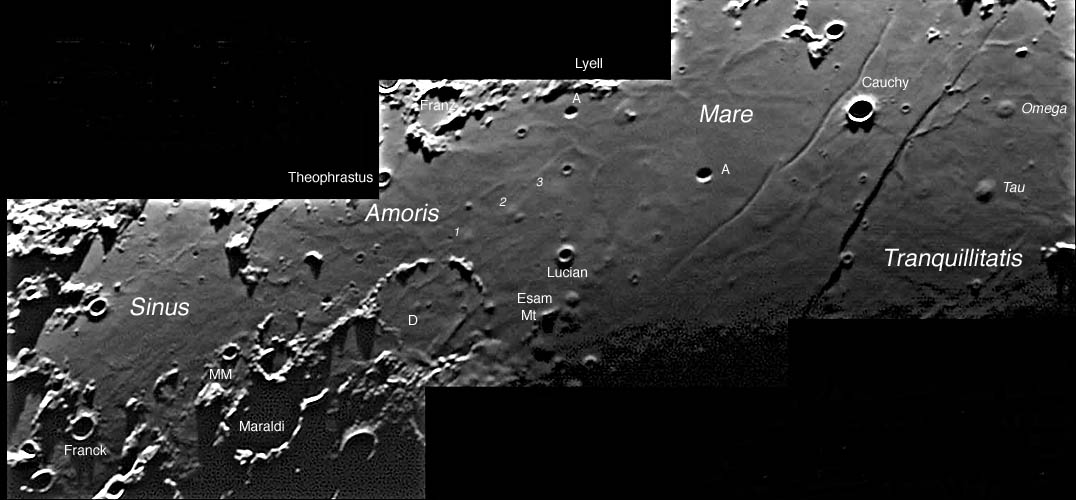
image by Paolo R. Lazzarotti
This is a repeat of an excellent LPOD from May 27, 2005. Thanks again, Paolo, for the fantastic image!
I thought I knew the Moon until I saw this image. The right side, showing Cauchy and nearby fault, rille and domes, is familiar, of course. The left side reveals features in the Bay of Love (Sinus Amoris) that I never knew existed. This little nook of the Moon is a hidden treasure trove of geologic delights. Lets start on the far left (north) and work southward. From Franck (diameter 12 km) toward the word Sinus the mare has a linear roughness that looks like lava flow margins. Of course this does not showup in the higher sun view of the Lunar Orbiter IV (plate 73-H3), so this may be the discovery image for these features. Maraldi Mountain (MM) looks jagged in this low sun, but higher illumination shows it to be a very odd, pancake like elevation - I wonder if it is volcanic? Inside the big nearly buried ring, Maraldi D, are two hills that may be remnant central peaks, a pitted dome, and a straight, sharp-edged ridge. Mt. Esam (why was this minor hill named?) is about in the middle of a line of domes; three tiny ones are below Esam and a large pitted dome is just above it. Three more apparent small domes extend this line to the right (south) of Lucian. These 7 domes make up the longest line of domes I know of on the Moon, and strongly suggest they all erupted from a fissure. A shorter line of 3 larger domes (1, 2, 3) occurs north of Lucian. The low lighting near Cauchy reveals many mare ridges (as well as domes). Interestingly, many of the ridges stop at the fault, rather than continuing on the other side. This is peculiar. Finally, did you notice the rimless pits (Cauchy A and Lyell A are the biggest but there are others)? Paolo’s image establishes the Amoris-Cauchy area as one of the leading volcanic concentrations on the Moon. Why here?
Technical Details:
April 13, 2005. Planewton DL-252 telescope + Lumenera LU075 M camera + Edmund Optics R+IR filter; 300 of 4000 frames. This is CAW’s strongly enhanced version - to see the original got to the earlier LPOD.
Related Links:
Rükl plate 25 & 36
Paolo’s website
Yesterday's LPOD: A Forgotten Map
Tomorrow's LPOD: Great Globular Moon
COMMENTS?
Register, Log in, and join in the comments.



